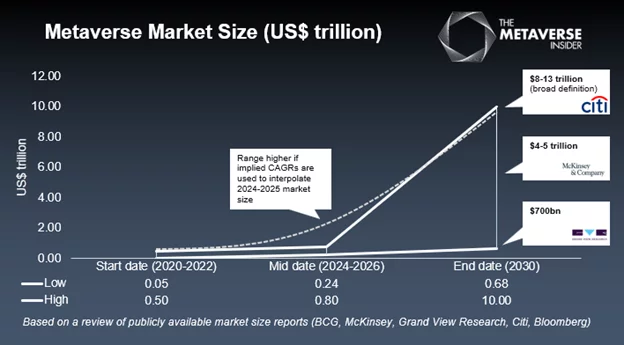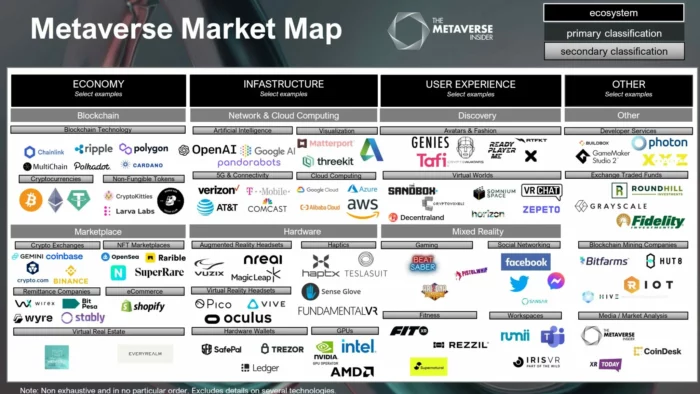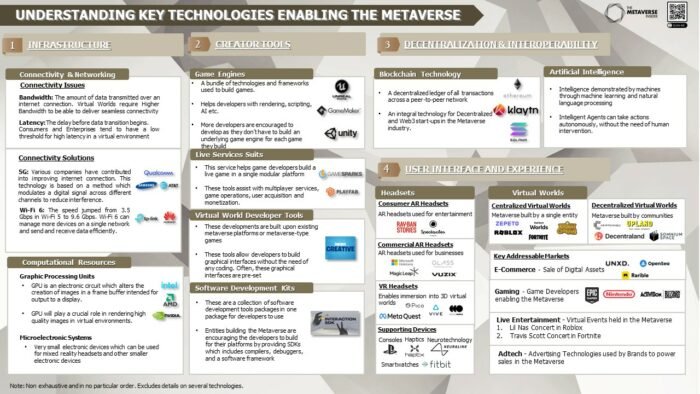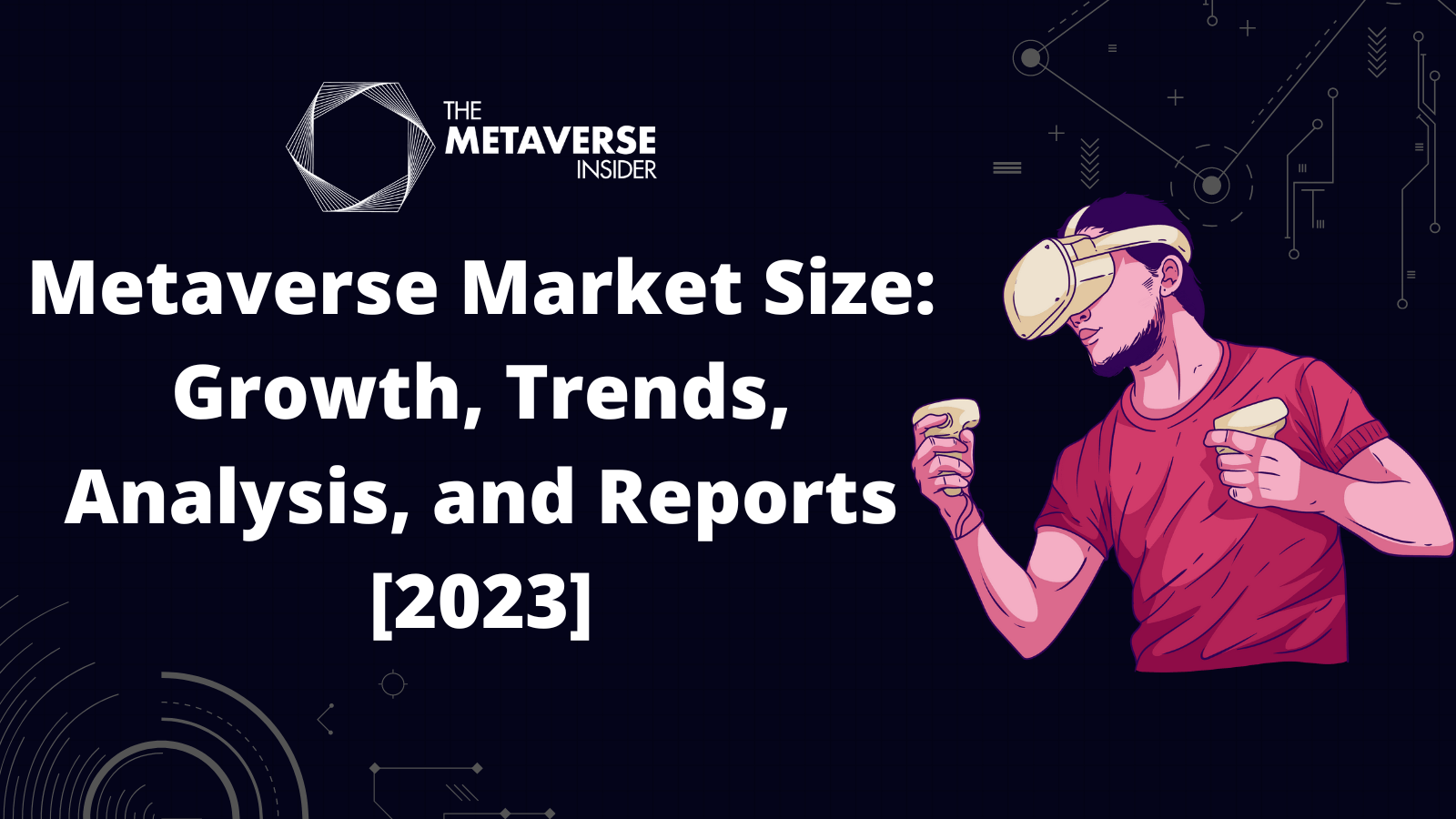The following in-depth article explains how the Metaverse Market Size is calculated. There is also an explanation of the process of calculations, assumptions made, and sectors involved. This article combines all our previously published metaverse sizing articles in one place to help the reader understand the Metaverse market size in its entirety.
Metaverse Insider recently launched a detailed market report that is available for purchase.
For inquiries, please reach out to Wazarat Ali Hussain at [email protected] to learn more about our research and analysis.
Disclaimer: This should not be construed as investment advice. It is very important to note that there are several risks associated with investing in this space since it is relatively new. Investors must conduct their research before making a decision.
Metaverse Market Size Expected to Hit 5.8 Trillion by 2030
Metaverse market sizing has significant challenges and complications. At the Metaverse Insider, we have studied and analyzed many market reports predicting what the metaverse market size could become by the decade’s end. While the market size prediction varies from report to report, all analysts and observers agree that the metaverse market is set to proliferate over the next decade as it disrupts various industries and sectors around the globe.
Metaverse is a convergence of developed and refined technologies for decades. As these technologies intersect and are implemented, they can transform many established industries in the next seven years. Since 2021, many studies and reports have pegged the Metaverse market size between $800 billion and over $13 trillion by 2030.
Meta-analysis of the Metaverse Market Size
This in-depth article analyzes why there is a wide range and the most reasonable estimation of the future Metaverse market size.
However, to understand the Metaverse market size, we first need to understand what the Metaverse is.
What does the Metaverse Market Size mean?
The Metaverse Market Size is a measure of the estimated worth of digital assets that have been created, traded and owned within virtual worlds and online communities. It’s an important metric for understanding the growth potential of this burgeoning industry, as well as the size of the market that could be tapped by businesses in this space. With the rise of new technologies like blockchain and cryptocurrency, we are likely to see an even larger Metaverse Market Size.

Calculating market size
The purpose of calculating a market size is to understand the potential revenue made in a particular industry – i.e. to find the Total Addressable Market (TAM). The market size calculations help industry stakeholders who research the opportunity in the market and study which sectors are the most important.
If interested in market sizing of other markets, check out our sister companies’ Quantum Computing Market Size.
A market is made up of sectors. The market size of each sector in a given year equals the total number of all transactions of all companies multiplied by the price they were at.
Revenue = price (amount product is sold for) x volume (number of units sold)
The above formula is used to calculate the revenue for each company. Please note most companies offer multiple products and services in numerous sectors.
The market size of a given sector = the total revenue of all companies.
The forecasted market size is of more interest to industry analysts as it helps predict a particular industry’s growth potential. The forecasted market size predicts the total revenue of all companies in each industry sector.
Calculating the current market size (2024) and the forecasted market size (2030, in this case) helps calculate the forecast growth rate or Compound Annual Growth Rate (CAGR).
Applying market sizing to the Metaverse
The Metaverse market size is the total revenue achieved in all sectors of the metaverse market in a given year.
Metaverse market size meta-analysis
The Metaverse Insider team analyzed forecasts from reputable organizations such as Citi, BCG, and McKinsey and general “research” companies.
We zoned into relatively recent reports released after Facebook changed its company name to Meta. The reports we analyzed have had a consistent end date of 2030.
Out of all the recent Metaverse market reports, Citi’s report presents the most bullish case, which predicts the Metaverse market size to be $13 trillion by the end of the decade. For reference, this valuation is higher than China’s Gross Domestic Product (GDP). While this may seem like a bold prediction, commentators such as Clive Justice of KPMG have suggested that this could be a conservative estimate.
Citi predicted that the total market size of the Metaverse could be between $8 trillion and $13 trillion by 2030, with around 5 billion users. Please note the Metaverse does not necessarily need to be accessed through a VR headset. A device-agnostic Metaverse can be accessed through a computer, gaming console, and smartphone.
While Citi’s report is the most generous prediction, McKinsey’s work has been the most detailed publically disclosed market report of the Metaverse. McKinsey revealed a metaverse market size of between $4 and $5 trillion by 2030, implying a 40 – 50% CAGR.
A McKinsey case study
The McKinsey metaverse market sizing explanation is explained in great detail in Appendix B. This Appendix is in great detail which explains how McKinsey got to their conclusions. To summarize, they:
1) Identified all consumer and enterprise use cases. Each use case explains Mckinsey’s research and analysis. The numbers of each sector are not included.
2) Made assumptions around penetration rates. Not all sectors have a 100% penetration rate in the Metaverse industry yet. Each penetration rate was based on expert interviews.
These analyses can have unprecise ways of gathering information as many assumptions need to be made while making predictions. McKinsey’s method of forecast market sizing is based on assumptions around assumed growth rates and importance of certain Metaverse technologies in future markets based on expert opinions.
Understanding the Metaverse Market Landscape, Size, and Growth
Metaverse Insider launched a report which analyzes the 2030 Metaverse Market Size. According to our calculations, the Metaverse market size will be around 5.8 trillion by 2030. The Metaverse industry is fast-evolving and still at a very initial stage. The potential of the Metaverse is debated (which is reflected in the various market size predictions). We conducted thorough research on the Metaverse market size and identified vital sectors involved in building the Metaverse. In this part of the article, lets go through our methodology of calculating the Metaverse market size.
See also: What is Metaverse? Guide into the Future of Digital Reality
Studying Precedent Market Reports

As mentioned before, some great resources have analyzed and predicted the metaverse market size. All these reports indicate the rapid progression of the Metaverse market with various numbers. Studying and analyzing the works of great analysts was the first step of Metaverse Insider when calculating the Metaverse Market Size for 2030. The following graphic shows the predictions of McKinsey & Company, Citi, and Grandview Research. The projections of all reports vary greatly.
Dissecting the Metaverse Market Map

Predicting the Metaverse Market Size is a challenging task. To be able to make educated assumptions and calculations, it is essential to identify the sectors which make up the Metaverse market. Dissecting the Metaverse market map helps to distinguish between the different sectors of the Metaverse market and helps identify their penetration rates in the Metaverse market. Each industry has particular market-leading companies and other various emerging companies. We are a very early stage of the Metaverse market, and thus, the future market leaders are yet to be determined.
Understanding Key Enabling Technologies

While it is a challenging task to determine the future market leaders and the potential of each market sector, identifying technologies which will have a significant impact in the metaverse market is more appropriate. Many Web2 tech giants have invested heavily in the Metaverse. Companies like Meta and Microsoft identify the technologies that will have a more significant impact and have doubled down on these investments. To make a more informed market sizing report, we thoroughly studied the underlying technologies which will make up the metaverse industry. Rather than just researching and analyzing the metaverse concept, we conducted a deep dive into the core technologies that make up the metaverse industry. These technologies will shape how we experience the internet and impact our day-to-day lives in the upcoming years.
Through triangulating our in-depth study, analyzing other forecasts, and creating a map of all key-enabling technologies of the Metaverse, we were able to refine the data to calculate a robust prediction of the metaverse market size and trajectory.
Market Size Calculations Methodology
The calculation of the metaverse market sizing consists of two methods, the bottom-up approach and the top-down approach. We conducted both methods to triangulate the best market sizing outcome.
Bottom-Up Approach
Having studied all technologies and markets in the metaverse industry, we could conclude which sectors make up the metaverse market without any missed sectors or overlaps. Having studied many reports and analyses, we decided that the best way to conduct a market sizing report would be to divide the market into consumer and enterprise markets. While the consumer markets are well-defined and established, the enterprise markets are currently being established.
Here are the consumer markets we analyzed for metaverse market size calculations.
- Gaming
- eCommerce
- Live Entertainment
- eLearning
- Health & Fitness
- Advertising
- Digital Assets
- Headsets
The aforementioned sectors make up the consumer side of the Metaverse market. Narrowing down the consumer markets consisted of thoroughly studying the technology being developed for the Metaverse – directly affecting the consumers/customers. We narrowed down two eight distinctive markets that comprise the Metaverse involving consumers. These 8 sectors include the consumer metaverse market and don’t miss any market sector.
Having identified and defined each consumer sector, we examined each market sector individually. We studied each sector’s market reports separately and independently analyzed each sector’s market sizes. We could calculate their growth rates and make educated predictions on each market’s trajectory till 2030.
All eight sectors mentioned in our consumer markets list above have an essential role to play in the future of the Metaverse. However, each industry has a limited penetration rate in the metaverse market. For example, gaming is a huge industry and not all games launched can be identified as a “metaverse game.” For example, Candy Crush, a popular mobile gaming application, cannot be identified as a metaverse game. Meanwhile, Roblox is considered a Metaverse game as it allows users to build experiences and constantly evolves. So are all multiplayer games considered to be metaverse games? In our quest to find which = game is regarded as a metaverse game, we calculated the penetration rates of each sector.
The Metaverse has a lot of enterprise-based application cases. Examples of well-known enterprise use cases for the Metaverse include governments, financial institutions, and investment funds for securities and securities. Conversely, examples of enterprise use cases of the Metaverse include the media and market analysts (such as Metaverse Insider). These markets had to be severely deconstructed even though they play a vital role in the Metaverse and many other use cases. They overlap significantly and are much more uncertain than consumer markets, just as the markets mentioned above. Enterprise use cases are still in their infancy, while consumer market use cases are beginning to emerge.
Top-Down Approach
We began by thoroughly analyzing each area of the Metaverse using a bottom-up strategy. This involves a lengthy process that calls for investigation and analysis. To accurately predict the market size, however, requires making a lot of assumptions about the Metaverse. As a result, we also tried estimating the size of the metaverse market from the top down. We have used the metaverse market’s share of the global economy for this strategy. Getting the overall digital economy’s market size is necessary for this.
Currently, Web2 titans rule the digital economy (many of which are pivoting towards the Metaverse). The existing market environment of the entire digital economy and how it will change over the next eight years were the subjects of our investigation. We firmly believe that as the internet’s penetration increases, the digital economy will expand in rural areas just as it has in metropolitan areas over the previous two decades. Furthermore, as the adoption of the critical enabling technologies rises, the tech behemoths that surpassed numerous Web 1.0 enterprises to become market leaders in their respective fields will try to avoid the same thing happening to them. So, in addition to the continued growth of internet usage and the digital economy, the Metaverse will also become more pervasive within it. The reorientation of the product offerings by tech behemoths like Meta, Microsoft, and Epic Games and the emergence of new start-ups will enable this penetration.
Metaverse Market Forecasts
The team at Metaverse Insider conducted research that predicts the global metaverse market would reach 5.79 trillion by 2030 and expand at a CAGR of 45%.
Since the publication of Neal Stephenson’s book Snow Crash in 1992, the idea of the Metaverse has been around and contains ideas and innovations that have been developing for years. Today, the phrase “Metaverse” refers to various cutting-edge technologies, including blockchain, 5G, and mixed reality. Recent years have seen a sharp increase in commercial interest in the Metaverse, with important tech companies like Microsoft, Nvidia, and Meta (previously Facebook) investing extensively in this new field.
The approaches used in the present set of metaverse market size evaluations are largely ambiguous and opaque. In addition to analysing various market sizing estimates, Metaverse Insider has also provided a guide on how to compute the Metaverse Market Size here. Using a bottom-up analysis of commercial markets, along with a top-down analysis of the digital economy as a percentage of the overall economy and the Metaverse inside it, Metaverse Insider estimated a 5.8 trillion market size in 2030. In an article published by Metaverse Insider, our methodology is explained in greater depth.
Methodologies used in the present range of metaverse market size estimations could be more transparent and precise. Metaverse Insider has previously released the Metaverse Market Size calculation guide and an Analysis of Other Market Sizing Reports. According to Metaverse Insider’s methodology, the global market for the Metaverse is expected to be worth 5.8 trillion in 2030 when a bottom-up analysis of commercial marketplaces is combined with a top-down analysis of the digital economy as a percentage of the overall economy. A detailed explanation of our process was published in an article.
The Metaverse, valued at 161 billion in 2021, is expected to expand at a CAGR of 45% through 2030 due to growing e-commerce, rising demand for VR/AR devices, and more applications for digital assets.
Metaverse Insider has noticed a need for high-quality market data for these businesses to research as tech behemoths and VC-backed start-ups want to invest in the Metaverse Ecosystem. To address this, the Metaverse Insider team combined open-source data, expert interviews, and surveys to analyze the Metaverse market comprehensively.
Calculating Metaverse Market Size
As per our calculations, $5 trillion represents a sizable market for the Metaverse if the industry really does grow at 45% CAGR. According to projections made by McKinsey & Company, Citi, and Grandview Research, the potential market size of the Metaverse varies greatly. This discrepancy results from different analysts’ varied expectations for how the Metaverse will develop in the future. For instance, some analysts might predict that businesses using blockchain technology will grow by 20% yearly, while others may indicate that it could be less than a 10% growth.
Additionally, some market sectors in the Metaverse are recognized by experts while others are not. For instance, some analysts may use gaming outlets like Fortnite in their calculations, while others may not.
The process of calculating Metaverse Market size can be summarised as follows:
– Identify the sectors that are involved in the Metaverse or are likely to be in the future.
– Estimate the most up-to-date market size of each sector and their growth rates. For this case, our most recent market size is 2021.
– Calculate the penetration rate of Metaverse in each sector.
– Calculate the Implied Metaverse Market Size.
– Calculate the implied growth rate CAGR.
Metaverse Market Sectors Involved
The Metaverse Market is made up of a variety of sectors, each offering distinct products and services. This rapidly expanding industry has seen tremendous growth over the past several years, creating countless opportunities for those looking to invest or work within it. From virtual reality to augmented reality, blockchain technology to gaming, the Metaverse market offers customers an array of options to explore and purchase. Regardless of the type of buyer, investor or entrepreneur looking to enter the Metaverse market, there are a multitude of sectors for potential venture capital and long-term gains. Thus, let’s investigate them in detail.
Blockchain
Blockchain technology records a peer-to-peer network’s transactions in a ledger. This technology aims to provide participant confirmation and transaction identification without requiring a centralized authority. The Bitcoin whitepaper from 2008/2009 helped popularise a technology that is today a crucial component of the financial and technology sectors. The technology driving many Defi and Web3 firms is blockchain.
The blockchain industry will include all Layer 1 and Layer 2 blockchain technologies and their use cases for our Metaverse Market Sizing. Consequently, the calculation will also consider NFTs and cryptocurrencies (tokens). Many well-known virtual worlds, including Decentraland and The Sandbox, have their native tokens (cryptocurrencies) and NFTs.
We won’t include cryptocurrencies in Metaverse Insider’s Market Sizing Report that are unrelated to the Metaverse. The decision here may require judgment. For instance, Ethereum may or may not be necessary in the Metaverse Report, depending on the analyst. The ERC-20 tokens will be a part of the Metaverse since they are widely used in decentralized virtual worlds.
NFT markets and cryptocurrency exchanges will also be included in the blockchain industry. Several businesses, including OpenSea, Binance, and Crypto.com, are involved in the blockchain (and metaverse) sector.
Metaverse eCommerce
Over the past ten years, the eCommerce sector has grown significantly, with companies like Shopify and Amazon emerging as critical players. Additionally, the Covid19 pandemic and ensuing worldwide lockdowns aided in the expansion of this sector in numerous new nations. Many brands believe that the transition to Web3 and Metaverse is a result of the pandemic and lockdowns.
As a result, several well-known companies are looking to participate in the Metaverse by purchasing virtual property, starting NFT initiatives, or hosting virtual events. As companies like Nike, Lacoste, and Wrangler see a chance to be early players in the Metaverse realm, virtual fashion for avatars is growing in popularity. Discover some of the companies making investments in the Metaverse by clicking here.
Additionally, augmented reality is increasingly widely used in online sales, giving many products a genuine feel. Companies like Matterport enable purchasers to explore a house as if they were there virtually. A similar strategy is used by traditional Web2 eCommerce businesses, who incorporate augmented reality with many of their products.
Artificial Intelligence (AI)
Since the development of AI would dramatically enhance user experience in virtual worlds, it is essential to the Metaverse. Mark Zuckerberg said that artificial intelligence may be our most important technological advancement at the Meta event “Inside the lab: Building for the metaverse and AI.” Whether they are decentralized or centralized gateways, this assertion implies that AI and machine learning will play a crucial part in the developing Metaverse virtual worlds. The significance of artificial intelligence in the Metaverse was examined in this study by Metaverse Insider. The picture below demonstrates that Supervised Learning, Unsupervised Learning, and Reinforcement Learning are all essential components of the Metaverse and are therefore taken into account when estimating the size of the Metaverse Market.
5G & Connectivity
Connectivity and 5G technology are essential parts of the Metaverse Market. Internet access has become commonplace because of advancements in telecommunications. The Metaverse sector needs seamless connectivity if it is to grow swiftly. Therefore, it should be simple for cellular devices to connect. The fastest-growing connectivity technologies for the Metaverse industry include Bluetooth, Wi-Fi, and 5G. Therefore, these Connectivity technologies that power the Metaverse Industry must also be considered when calculating the Metaverse Market Size.
As we examine how vast these virtual worlds are, bandwidth emerges as a crucial aspect of the Metaverse. Matthew Ball cites the Microsoft Flight Simulator as an example in his book. This game has a 500,000,000 square kilometre world and boasts 1.5 million unique structures and two trillion uniquely generated trees. This kind of virtual world needs a large quantity of bandwidth to function. The demand for more bandwidth and better connectivity will soar as virtual worlds expand. Since the success of technologies like 5G is intimately related to the success of the Metaverse Industry in many ways, flawless connectivity will therefore be a vital component of the Metaverse.
Metaverse Cloud Computing
The development of a virtual reality environment requires the large-scale processing and storing of data. Cloud computing will become a crucial component of the Metaverse Market Size as 3D, and VR technology becomes more widely used, and adoption of these technologies becomes a part of gaming and remote work. Thus, Cloud Computing is considered when estimating the size of the Metaverse Market. The penetration of cloud computing will increase until 2030 as metaverse companies continue to grow and expand (thus, continue to require cloud storage).
Metaverse GPUs and mining chips
Calculating the Metaverse Market Size depends on the hardware that runs the Metaverse. Businesses like NVIDIA and Intel are developing mining processors and graphics processing units to increase efficiency and power 3D and blockchain technology massively. The demand for GPUs will soar as the use of virtual worlds (particularly in 3D) increases. The market for GPUs will expand as there is a demand for real-time rendering of virtual environments at high resolutions. As a result, the calculations to anticipate the metaverse market’s size will consider an increase in GPU and mining chip sales.
Metaverse Gaming (& VR Gaming)
Gaming is one of the essential aspects of the Metaverse Market Size. Currently, multiplayer games have gained much popularity, with games like Fortnite, Grand Theft Auto, and Call of Duty gaining much traction. These games have a common theme. They allow multiplayer options and friends to interact online while conducting a specific activity.
Virtual worlds like The Sandbox and Decentralan let people develop on their platforms and earn money from their experiences. The funding for these virtual worlds has increased, even though the decentralization component of gaming has yet to acquire significant popularity. As a result, financing has been provided to Web3 gaming studios like Gala Games, and established gaming studios like Epic Games are placing bets on the future of Web3 gaming. To read our in-depth piece on gaming in the Metaverse, which explains the infographic below, click here.
Fitness: As more individuals become aware of how they might improve their health and live healthier lives, the fitness business has gained traction. Recreational pursuits like neighbourhood youth and adult sports leagues may be an excellent idea for this industry. As more people start working out at home to save time, the Metaverse might play a significant role in the next chapter of the fitness business. In-home exercises have been made easier by VR headsets like the Oculus. People who want to do some boxing at home frequently play games like Thrill of the Fight. To examine how the fitness sector responds to the Metaverse, we will include it in our analysis of the Metaverse market size.
Metaverse Social Networking
A vital component of the Web 2 era of the internet was social networking. Social media platforms like Facebook and Twitter have grown to be essential to the global community. Social media will change in the Metaverse as platforms like Twitter roll out NFT capabilities and firms like Facebook change their company name to Meta.
Users who switch to the Metaverse will indeed cause social media to change. To estimate the size of the Metaverse market in 2030, it is critical to comprehend how social media will change during the following seven years. Users may switch to online communities like Horizon Worlds and Decentraland, which are already factored into the gameplay computation.
Workspaces: Applications for virtual work have become indispensable in many offices as workers start working remotely or adopt hybrid work models. Microsoft wants to improve the virtual workplace, so it purchased Skype and created Teams. To enable a team to operate remotely in virtual reality, many apps are being developed in the virtual world. Virtual workspaces will significantly impact the scale of the Metaverse market as more businesses continue to operate remotely.
Metaverse Development Services
Numerous development organizations are facilitating virtual reality construction initiatives. Compared to 2D platforms, working in 3D presents more challenges that need to be fully resolved. The Metaverse Market Size will be significantly impacted by development organizations, which facilitate growth in the Metaverse by offering development services. Numerous of these firms support the creation of NFT initiatives for virtual spaces in virtual worlds by major brands like Nike and Dior. The number of Metaverse users will increase with the demand for development services.
As blockchain technology becomes more prevenlant, we also added blockchain development services in this segment of the Metaverse market size. Blockchain technology is incorporated into almost all Web3 and virtual world gaming companies’ in-game economies.
Metaverse Media / Market Analysts
Metaverse media organizations and market analysts like Metaverse Insider are essential in educating the public about metaverse projects. They also help investors and developers make informed decisions about how the Metaverse is developing and which sectors to focus on. Thus Media / Market Analysts (who relate to the Metaverse) will be a part of the Metaverse market size.
If interested in our Metaverse Market Sizing report, check out our Table of Contents and Pricing.
Contact us at [email protected] to request access.
Complications with calculating Metaverse Market Size
We can determine the current market size of the calculations once the key calculation areas have been identified. Calculating their most recent market size yields this result (total annual revenue). For each sector, the most recent data we have is for 2021. As a result, we use the market’s size as of 2021 and anticipate annual growth. The sector’s expected future development is the basis for the growth rate yearly.
How did we determine the size of the markets in each sector? Based on our available resources, we estimate the potential size of the sector’s market. These forecasts aid in our understanding of the reasons behind the numerous inconsistencies in the estimation of the metaverse market size. While some businesses may project a 10% growth rate for a certain sector, others may project a 30% growth rate. As one might expect, these variances have a big impact on the ultimate estimate of the Metaverse market size.
After calculating the market size for each sector, we examine its penetration rate within the Metaverse Industry. This is carried out because not all of these industries entirely comprise the Metaverse Industry. For instance, the Media / Market Analysts industry only partially encompasses the Metaverse. All GPUs will not power the Metaverse. A small subset of Media covers the Metaverse. Some media outlets cover topics including sports, education, and entertainment. The penetration rate thus determines the degree to which the Metaverse Industry impacts each industry. For instance, just 1% of media outlets might cover the Metaverse.
The size of the Metaverse market, however, could increase in the upcoming years as more businesses begin to focus on this space. It is significant to remember that various experts may arrive at different conclusions in this calculation. Some would include all tech media outlets, while others might consist of financial media in their penetration calculations. These discrepancies in opinion can provide a wide range of estimates for the size of the metaverse market.
In conclusion, the metaverse market size calculation is essential to understand the state of the industry and where the industry good be heading in the upcoming years. With the emergence of technologies like blockchain and virtual reality, we expect a meteoric rise in an industry currently in its infancy and deals with a lot of skepticism.


















